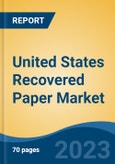Speak directly to the analyst to clarify any post sales queries you may have.
10% Free customizationThis report comes with 10% free customization, enabling you to add data that meets your specific business needs.
As consumer and corporate preferences shift toward sustainable practices, demand for recycled paper products has risen significantly. This growing focus on eco-conscious manufacturing and waste minimization is further supported by federal and state regulations that promote recycling and limit landfill use. As sustainability remains a national priority, recovered paper is expected to remain an essential component of the U.S. recycling and waste reduction strategy.
Key Market Drivers
Environmental Awareness and Sustainability
The rising emphasis on environmental protection and climate-conscious behavior, particularly among younger demographics, is boosting demand for sustainable paper products. Consumers increasingly prefer items made from recycled materials, recognizing their lower environmental impact. Recovered paper products, such as recycled packaging and paperboard, are gaining popularity for their ability to reduce deforestation and energy consumption. The growing popularity of sustainable packaging, especially for e-commerce and retail, further contributes to this trend. As businesses seek to align with sustainability goals and consumer expectations, demand for recovered paper as a primary raw material in packaging continues to grow, reinforcing its role in supporting environmentally responsible production.Key Market Challenges
Contamination Issues
Contamination remains a significant challenge in the recovered paper market. Non-paper materials such as food waste, plastic liners, or grease can degrade paper fiber quality, making it unsuitable for high-grade recycled products. This results in lower output quality, reduced fiber recovery rates, and increased processing complexity. To manage contamination, recycling facilities must invest in advanced sorting systems and cleaning technologies, raising operational costs. These increased expenses can strain profitability and limit market participation. Moreover, equipment damage due to foreign materials causes unplanned downtime and maintenance costs, further impacting efficiency. Addressing contamination is essential to maintain quality standards and ensure the economic viability of recovered paper recycling operations.Key Market Trends
Growth in E-commerce and Packaging Demand
The surge in U.S. e-commerce activity is a major trend driving demand for recovered paper, especially in packaging applications. Online retail continues to expand rapidly, with projections indicating revenues will grow from USD 1.2 trillion in 2024 to USD 1.8 trillion by 2029. This expansion is increasing the consumption of corrugated cardboard and sustainable packaging - key applications for recovered paper. The pandemic further accelerated the shift toward online shopping, heightening the need for recyclable and eco-friendly packaging solutions. As retailers and logistics providers look to reduce their environmental impact, recovered paper continues to gain favor as a preferred material for cost-effective and sustainable packaging.Key Market Players
- International Paper
- Westrock Co
- Pratt Industries, Inc.
- Sonoco Products Company
- Cascades Inc
- Packaging Corp Of America
- Koch Industries
Report Scope:
In this report, the United States Recovered Paper Market has been segmented into the following categories, in addition to the industry trends which have also been detailed below:United States Recovered Paper Market, By Grade:
- Low Grade Paper
- High Grade Paper
- Brown Paper
- Others
United States Recovered Paper Market, By Type:
- Printing & Writing Paper
- Newsprint
- Tissue
- Containerboard
United States Recovered Paper Market, By End User Industry:
- Food & Beverage
- Electrical & Electronics
- Automotive
- Pharmaceuticals
- Others
United States Recovered Paper Market, By Region:
- Northeast
- Midwest
- West
- South
Competitive Landscape
Company Profiles: Detailed analysis of the major companies present in the United States Recovered Paper Market.Available Customizations:
With the given market data, the publisher offers customizations according to a company's specific needs. The following customization options are available for the report.Company Information
- Detailed analysis and profiling of additional market players (up to five).
This product will be delivered within 1-3 business days.
Table of Contents
Companies Mentioned
- International Paper
- Westrock Co
- Pratt Industries, Inc.
- Sonoco Products Company
- Cascades Inc
- Packaging Corp Of America
- Koch Industries
Table Information
| Report Attribute | Details |
|---|---|
| No. of Pages | 85 |
| Published | June 2025 |
| Forecast Period | 2024 - 2030 |
| Estimated Market Value in 2024 | 41.84 Million Tonnes |
| Forecasted Market Value by 2030 | 57.37 Million Tonnes |
| Compound Annual Growth Rate | 5.6% |
| Regions Covered | United States |
| No. of Companies Mentioned | 7 |









